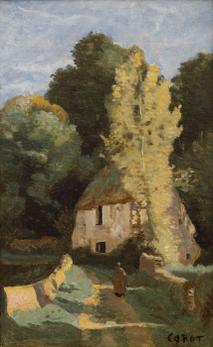Lot #172

Jean-Baptiste Camille Corot (1796–1875)
House in the Forest
Estimate: 1,500,000 CZK - 2,500,000 CZK
1,200,000 CZK
Jean-Babtiste Camille Corot came from a prosperous merchant family, which allowed him to attend the grammar school in Rouen. He did not excel there, though; therefore, he continued his apprenticeship with a silk merchant in Paris. Despite his inclination towards art, his parents hadn’t permitted him to fully devote himself to it until 1822, when he was finally granted a regular allowance, which allowed him to become an independent artist. In the same year, he entered the studio of Achille Etna Michallon, then studied with Jean-Victor Bertin, thanks to whom he received education in neoclassicism based on, to a large extent, the art of Claude Lorrain and French classicist landscape painting of the 17th century. He spent the years 1825–1828 in Italy, where he not only broadened his horizons but also created his first masterpieces. Already then, his natural talent became apparent, imbued with a sense of light, the structure of shapes and the atmospheric characteristics of nature. Later, his sightseeing trips also took him to Switzerland, the Netherlands, Belgium, and England. After returning to France, he repeatedly visited the forest of Fontainebleau, including the villages of Chailly and Barbizon; he became fond of the misty atmosphere there and gradually formed his unmistakable artistic expression. Although his compositions at that time were still often populated by figures of monks or melancholic young ladies, the landscape fully prevailed. Corot had already embarked on a path at that time, the result of which was a kind of conjunction between the classicist tradition and the new emerging trends of the second half of the 19th century – he thus became an inspiration for several great personalities of the younger generation and was then an essential turning point for the landscape painters of the Impressionist movement, namely for Claude Monet and his series of morning views of the Seine from the 1890s. Corot soon became a leading figure of his generation, regularly exhibited at the Salon (during his career, he presented up to a hundred paintings there), received numerous awards and devoted himself to charity. His position in Parisian society, where he was referred to as Père Corot (Father Corot) at the end of his life, included him among such names of world landscape painting as Claude Lorrain, William Turner, and John Constable.
The painting depicts a simple plein air dominated by green shades in which the road, the departing figure, and the mill in the background seem to immerse themselves. Everything illuminates harsh side light, casting long shadows. The brushwork is remarkably relaxed for its time and testifies to the author’s artistic freedom. Captured is a house called Château-Galland, owned by the old miller Pierre Corot, one of Camille Corot’s more distant relatives.
The artwork has an interesting provenance. It is known to have been in the collections of Alfredo Robaut, the artist who, among other things, compiled the first inventory of Corot’s work. Since 1903, the owner of the painting was Paul Durand-Ruel, a collector and one of the most influential art patrons of the turn of the 19th and 20th centuries. A curious story is mentioned in the artist’s inventory. In 1871, Alfred Robaut already owned the painting and brought it to the author, asking where he had painted it. Corot replied: “A Semur, parbleu!” (“In Semur, I swear!”), gave the painting a small retouch and signed it. The work was presented at the exhibition Corot 1796–1875 (Galerie Schmit, 12. 05. – 12. 06. 1971, No. 33, described and reproduced in the exhibition catalogue on p. 51, the exhibition stamp is on the reverse of the stretcher). The painting was also published and reproduced in the inventory of the artist’s work (A. Robaut: L‘Oeuvre de Corot, Catalogue raisonné et illustré, Paris 1905, Volume II, cat. No. 839, p. 270, fig. p. 271, under the title Semur – Maison a l'entrée d'un bois). The painting presents an exceptional opportunity for collectors to acquire the mature and high-quality work of the world-renowned artist. Presented in an elegant frame. Assessed during consultations by doc. M. Theinhardt, CSc., and PhDr. Š Leubnerová. The expertise of prof. R. Prahl, CSc., is attached.



